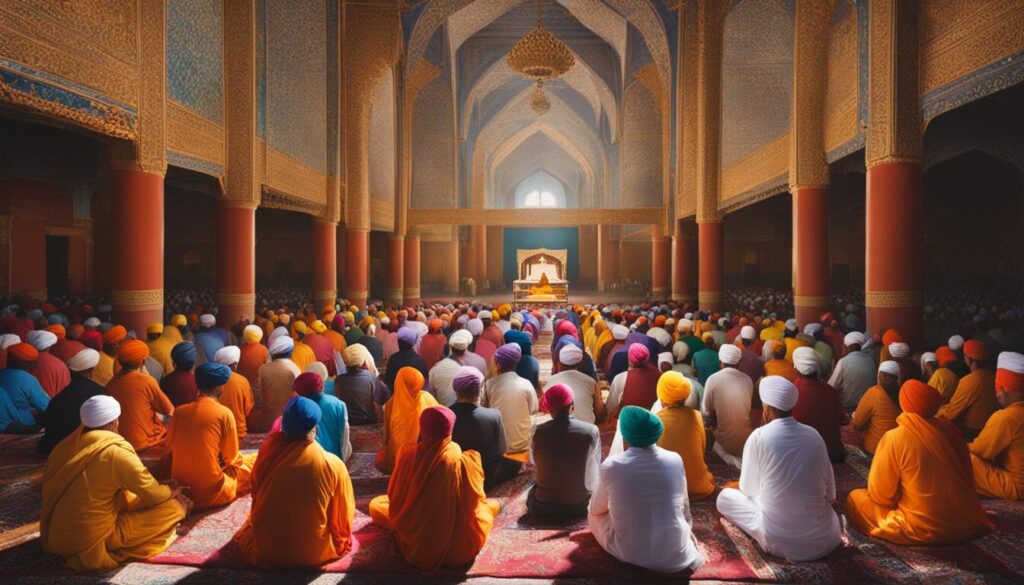Sikh Guru Granth Sahib and Hindu Scriptures are two significant religious texts that hold different beliefs and doctrines. While Hinduism is an ancient religion with a diverse collection of sacred texts, Sikhism emerged in the 15th century as a unique faith founded by Guru Nanak. This section will explore the key distinctions between the two and highlight their unique teachings.
Key Takeaways:
- Sikh Guru Granth Sahib and Hindu Scriptures represent two distinct religious traditions
- Hinduism is an ancient religion with a diverse collection of sacred texts
- Sikhism emerged in the 15th century and is founded by Guru Nanak
- Hinduism encompasses a wide range of deities, while Sikhism believes in one God
- Hinduism has numerous scriptures, while Sikhism’s primary scripture is the Guru Granth Sahib
Origins and History: Hinduism’s Ancient Roots and Sikhism’s Recent Emergence
Hinduism, one of the oldest religions in the world, traces its origins back to the ancient Indus Valley Civilization and the historical Vedic religion. The roots of Hinduism can be found in the rich cultural and spiritual traditions of the Indian subcontinent. Over thousands of years, Hinduism absorbed influences from various sources, including Dravidian folk religion and tribal beliefs, resulting in its diverse and inclusive nature.
On the other hand, Sikhism emerged as a distinct faith in the 15th century with the teachings of Guru Nanak. It grew out of the Sant-tradition of India, which emphasized divine love, truth, and social justice. While Hinduism had been established for centuries, Sikhism offered a fresh perspective and addressed the prevalent social and religious issues of its time. Sikhism’s emergence marked a new chapter in the history of religious thought and spirituality in India.
It is important to note that while Sikhism arose in the context of Hinduism, it is a separate and independent religion. Sikhism’s foundation is based on the teachings of the Sikh Gurus, who emphasized the principles of equality, service, and devotion to God. The unique historical context and distinct beliefs of Sikhism set it apart from Hinduism, despite some shared cultural and linguistic ties.
| Hinduism | Sikhism |
|---|---|
| One of the oldest religions in the world with ancient roots | Emerging in the 15th century as a distinct faith |
| Incorporates elements from diverse sources and traditions | Built upon the teachings of the Sikh Gurus |
| Diverse and inclusive nature | Emphasizes principles of equality and devotion to God |
*Table: A comparison of the origins and history of Hinduism and Sikhism
Concept of God: Many Deities vs. Monotheism
Hinduism embraces a diverse pantheon of deities, with different traditions focusing on various gods and goddesses. The belief in multiple gods allows for a rich tapestry of religious practices and mythologies within Hinduism. From Brahma, the creator, to Vishnu, the preserver, and Shiva, the destroyer, Hindus worship and revere a wide range of divine beings. Each deity represents different aspects of the ultimate reality, and devotees can choose to worship the god or goddess that resonates with them the most.
On the other hand, Sikhism follows a strict monotheistic belief, acknowledging only one God, known as Waheguru. This concept of a singular, all-encompassing deity is central to Sikh faith and distinguishes it from Hinduism. Sikhs believe in the formless nature of God, seeing Him as the ultimate truth and creator of the universe. The emphasis on monotheism in Sikhism reflects the teachings of Guru Nanak, who preached the oneness of God and rejected the worship of multiple deities.
In summary, Hinduism encompasses a multitude of deities, allowing for a diverse range of religious practices and beliefs. Sikhism, on the other hand, adheres to the principle of monotheism, believing in the existence of one God. These contrasting perspectives on the concept of God highlight the unique theological foundations of Hinduism and Sikhism.
Practices and Rituals: Varied Worship vs. Congregational Worship
Hinduism embraces a wide array of practices and rituals that reflect its diverse traditions and beliefs. These rituals often include meditation, yoga, communal worship, and offerings in temples. Hindu worship is centered around connection with various deities, with different traditions focusing on different gods and goddesses. The rituals vary from region to region and can involve elaborate ceremonies and festivals.
Sikhism, on the other hand, emphasizes congregational worship at Gurdwaras, which are Sikh places of worship. One of the core principles of Sikhism is “Sangat,” which encourages community participation in religious activities. Sikh practices revolve around the teachings of the Sikh Gurus and the Guru Granth Sahib, the primary scripture of Sikhism. Daily prayers, meditation, and the observance of the three pillars of Sikhism are integral to the Sikh way of life.
Sikh Practices
- Naam Japna: Sikhs practice the repetition of God’s name as a form of meditation.
- Kirtan: Congregational singing of hymns and devotional music is an essential part of Sikh worship.
- Seva: Sikhs believe in selfless service, and performing acts of kindness and charity is a fundamental practice.
- Langar: Sikhs have a tradition of providing free meals to all visitors, regardless of their background or faith, as a way of promoting equality and community.
While Hindu rituals often focus on personal spiritual growth and individual connection with specific deities, Sikh practices emphasize unity, community engagement, and service to others. Both traditions offer meaningful ways to connect with the divine, but their approaches to worship and rituals differ, reflecting the unique beliefs and values of each religion.
| Hindu Worship | Sikh Worship |
|---|---|
| Varied practices and rituals | Congregational worship at Gurdwaras |
| Focus on individual connection with deities | Emphasis on community participation and Sangat |
| Elaborate ceremonies and festivals | Prayers, meditation, and the observance of three pillars of Sikhism |
| Community offerings in temples | Seva (selfless service) and Langar (free community kitchen) |

Scripture and Authority: Numerous Texts vs. Guru Granth Sahib
Hinduism has a vast collection of scriptures that form the foundation of its religious teachings. These include the Vedas, Upanishads, Puranas, and various philosophical texts. Each of these texts holds significance and provides guidance for different aspects of Hindu belief and practice. The authority of these scriptures varies among different sects and traditions within Hinduism, with some texts considered more authoritative than others.
In contrast, Sikhism places primary importance on the Guru Granth Sahib as its scripture and source of authority. The Guru Granth Sahib is a compilation of writings from the Sikh Gurus and other enlightened individuals. It is considered the eternal Guru and holds the highest authority in Sikhism. Sikhs believe that the Guru Granth Sahib contains the divine wisdom and teachings necessary for spiritual growth and enlightenment.
To understand the differences in authority, it is essential to note that Hinduism has a decentralized structure, with various traditions and philosophies interpreting and valuing different texts differently. In Sikhism, the centralized authority of the Guru Granth Sahib ensures consistency and a unified understanding of the faith among Sikhs.
Sikh Scriptures and Guru Granth Sahib
The Guru Granth Sahib comprises 1,430 pages and contains hymns and teachings composed by the Sikh Gurus, including Guru Nanak Dev, Guru Angad Dev, Guru Amar Das, Guru Ram Das, Guru Arjan Dev, Guru Tegh Bahadur, and Guru Gobind Singh. It also includes contributions from other saints and devotees, highlighting the inclusivity and diversity of Sikhism.
Furthermore, the Guru Granth Sahib is considered a living Guru in Sikhism, and Sikhs treat it with utmost respect and reverence. It is placed on a throne-like platform in the Gurdwara, the Sikh place of worship, and is ceremoniously opened and closed every day. Sikhs turn to the Guru Granth Sahib for guidance, inspiration, and spiritual solace, seeking answers to life’s questions and dilemmas.
Hindu Scriptures and their Authority
Hinduism boasts a rich tapestry of scriptures, each offering unique insights and perspectives. The Vedas, comprising the Rigveda, Yajurveda, Samaveda, and Atharvaveda, form the foundation of Hindu thought and ritual practice. The Upanishads delve into philosophical and metaphysical themes, while the Puranas narrate ancient myths and stories. Additional texts, such as the Mahabharata and the Ramayana, provide epic narratives that teach moral and ethical values.
It is worth noting that within Hinduism, different texts hold varying levels of authority and importance. The Vedas are considered the most authoritative, with their rituals and hymns guiding religious practices. However, interpretations and beliefs surrounding these texts may differ across different Hindu sects and traditions. The authority of scriptures in Hinduism is often determined by the lineage of spiritual gurus and the traditions they follow.
Salvation and Afterlife: Reincarnation vs. Merging with God
In Hinduism, salvation is believed to involve breaking the cycle of birth, death, and reincarnation through the accumulation of good deeds and the practice of righteousness. This concept, known as moksha, is achieved through various paths such as devotion (bhakti), knowledge (jnana), and selfless action (karma yoga). Hindus believe that the individual soul (Atman) goes through a cycle of reincarnation, with each life determined by the actions and choices made in previous lives.
Sikhism, on the other hand, offers a different perspective on salvation and the afterlife. Sikhs believe that the ultimate goal is to merge with God by developing a personal and loving relationship with Him. This is achieved through meditation, prayer, and the practice of good deeds. Sikh doctrine emphasizes the importance of living a righteous life and serving others selflessly. Rather than seeking liberation from the cycle of reincarnation, Sikhs aim to merge their individual consciousness with the divine consciousness (Waheguru) while living a fulfilling and purposeful life.
While both Hinduism and Sikhism recognize the concept of karma and the cycle of reincarnation, their ultimate goals and paths to salvation differ. Hinduism focuses on liberation from the cycle of birth and rebirth, while Sikhism emphasizes the unity and oneness with God. These distinct beliefs shape the spiritual practices and teachings of each religion, guiding their followers on their respective paths to spiritual fulfillment.
Beliefs about Other Religions: Integration vs. Respect
In terms of their attitudes towards other religions, Hinduism and Sikhism take different approaches. Hinduism, with its syncretic nature, accommodates various beliefs and integrates other religions into its framework. This inclusivity is exemplified by the recognition and acceptance of Buddhism, Jainism, and Sikhism within Hinduism. Hindus recognize these religions as paths to spiritual enlightenment and often incorporate their teachings and practices into their own.
Sikhism, on the other hand, respects and acknowledges the teachings of other religions while maintaining its distinct identity. Sikhs believe in the teachings of the Sikh Gurus and recognize the importance of the Guru Granth Sahib as the embodiment of enlightened wisdom. They embrace religious diversity and strive to foster respect for all faiths. Sikhism teaches its followers to live harmoniously with others and to uphold principles of equality, justice, and compassion.
While Hinduism integrates and assimilates other religions, Sikhism treads a path of respect and coexistence. Both approaches have their merit and contribute to the overall religious landscape. Hinduism’s integration acknowledges the interconnectedness of various faiths, while Sikhism’s respect highlights the importance of maintaining one’s religious identity while appreciating others.
Key Differences in Beliefs about Other Religions:
| Hinduism | Sikhism |
|---|---|
| Accommodates and integrates other religions into its framework | Respects and acknowledges the teachings of other religions |
| Recognizes Buddhism, Jainism, and Sikhism as paths to spiritual enlightenment | Embraces religious diversity and strives for respect for all faiths |
| Incorporates teachings and practices from other religions | Upholds principles of equality, justice, and compassion |
Through their contrasting beliefs about other religions, Hinduism and Sikhism contribute to the rich tapestry of religious diversity. Whether through integration or respect, both religions teach valuable lessons about coexistence and understanding, ultimately fostering harmony among diverse communities.
Conclusion: Embracing Diversity and Unique Paths to Spirituality
Sikh Guru Granth Sahib and Hindu Scriptures represent two distinct religious traditions with their own unique doctrines and beliefs. While both share some similarities, it is essential to recognize the distinctions between the two.
By exploring the differences between Sikhism and Hinduism, we gain a deeper understanding of religious diversity. Embracing this diversity can lead to a greater appreciation for the various paths that individuals take on their spiritual journeys.
It is important to respect and acknowledge the beliefs of others while maintaining our own distinct identities. This approach fosters harmony among diverse communities and promotes a more inclusive and tolerant society.
Whether we follow the teachings of the Sikh Gurus or draw wisdom from Hindu scriptures, recognizing and honoring the unique paths to spirituality can enrich our lives and deepen our connection to the divine.
FAQ
What are the key differences between Sikh Guru Granth Sahib and Hindu Scriptures?
Sikh Guru Granth Sahib is the primary scripture of Sikhism, while Hindu Scriptures encompass a wide range of sacred texts from ancient Vedic religion.
How does Sikhism differ from Hinduism in terms of belief in God?
Sikhism is strictly monotheistic, believing in the existence of one God (Waheguru), whereas Hinduism encompasses a pantheon of deities.
What are the main practices and rituals in Sikhism and Hinduism?
Hinduism includes practices such as meditation, yoga, and temple worship, while Sikhism emphasizes congregational worship at Gurdwaras and daily prayers.
Which scriptures hold authority in Sikhism and Hinduism?
Sikhism recognizes the Guru Granth Sahib as the eternal Guru and highest authority, whereas Hinduism has a collection of scriptures such as the Vedas, Upanishads, and Puranas.
How do Sikhism and Hinduism differ in their concepts of salvation?
Hinduism aims to break the cycle of reincarnation through good deeds and righteousness, while Sikhism sees salvation as merging with God through prayer, meditation, and good deeds.
How do Sikhism and Hinduism view other religions?
Hinduism has a syncretic approach, integrating other religions, while Sikhism respects and acknowledges other teachings while maintaining its distinct identity.
What is the significance of religious diversity and unique paths to spirituality?
Embracing religious diversity deepens our appreciation for different faiths and fosters harmony among diverse communities.
 Skip to main content
Skip to main content


